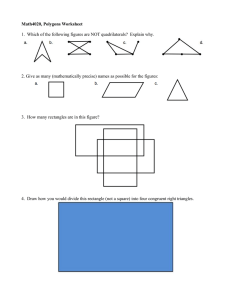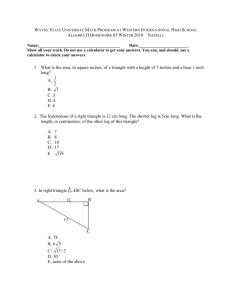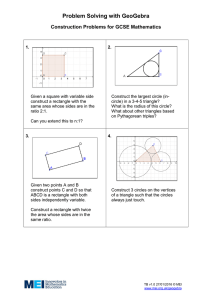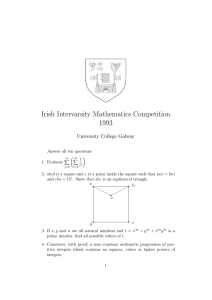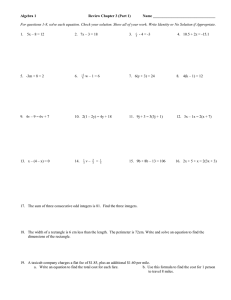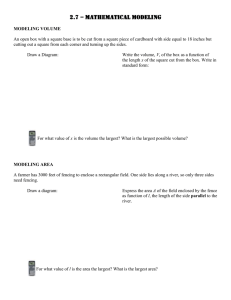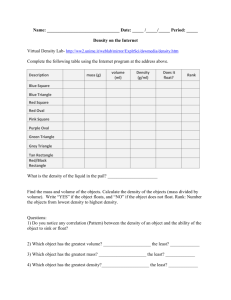Problem Solving 1 Introduction
advertisement
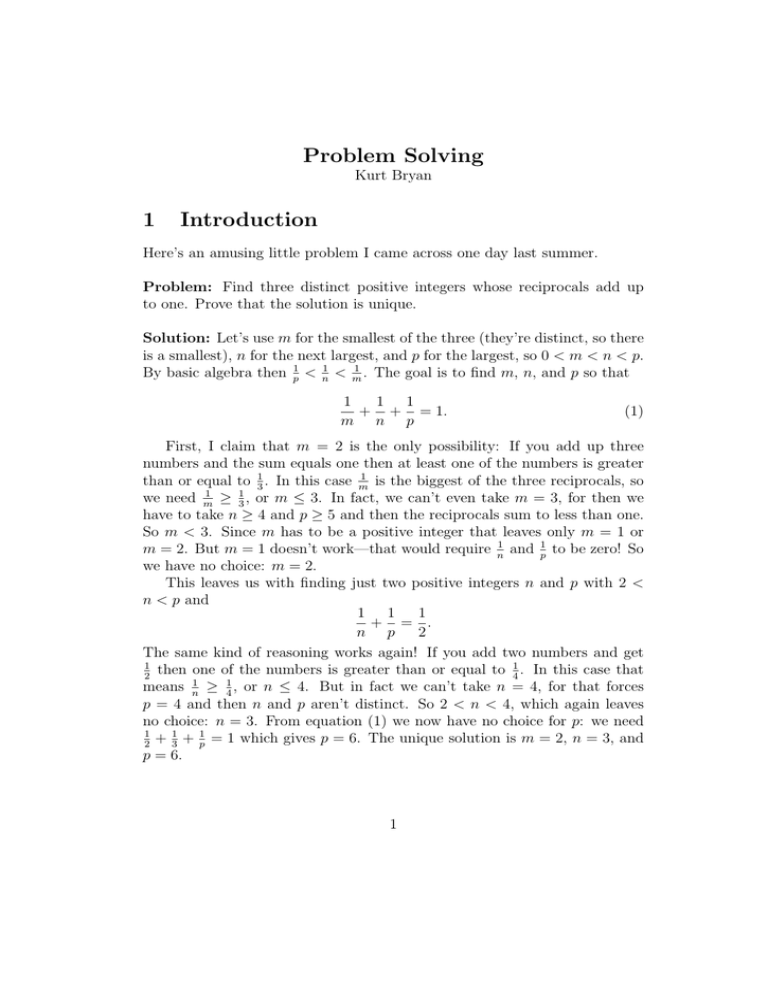
Problem Solving Kurt Bryan 1 Introduction Here’s an amusing little problem I came across one day last summer. Problem: Find three distinct positive integers whose reciprocals add up to one. Prove that the solution is unique. Solution: Let’s use m for the smallest of the three (they’re distinct, so there is a smallest), n for the next largest, and p for the largest, so 0 < m < n < p. By basic algebra then p1 < n1 < m1 . The goal is to find m, n, and p so that 1 1 1 + + = 1. m n p (1) First, I claim that m = 2 is the only possibility: If you add up three numbers and the sum equals one then at least one of the numbers is greater than or equal to 13 . In this case m1 is the biggest of the three reciprocals, so we need m1 ≥ 13 , or m ≤ 3. In fact, we can’t even take m = 3, for then we have to take n ≥ 4 and p ≥ 5 and then the reciprocals sum to less than one. So m < 3. Since m has to be a positive integer that leaves only m = 1 or m = 2. But m = 1 doesn’t work—that would require n1 and p1 to be zero! So we have no choice: m = 2. This leaves us with finding just two positive integers n and p with 2 < n < p and 1 1 1 + = . n p 2 The same kind of reasoning works again! If you add two numbers and get 1 then one of the numbers is greater than or equal to 14 . In this case that 2 means n1 ≥ 14 , or n ≤ 4. But in fact we can’t take n = 4, for that forces p = 4 and then n and p aren’t distinct. So 2 < n < 4, which again leaves no choice: n = 3. From equation (1) we now have no choice for p: we need 1 + 13 + p1 = 1 which gives p = 6. The unique solution is m = 2, n = 3, and 2 p = 6. 1 It took only a moment to figure this solution out. How’d I do so fast? Was it a brilliant insight? Hardly. In fact, my approach was quite methodical. Looking back over the problem, you should realize that although it looked hard, the individual steps consisted of nothing more than VERY easy algebra and “common sense.” You’re going to encounter a lot of problems like this in the next year (and beyond), on tests and homework. Perhaps you won’t be able to solve a given problem, but after seeing the solution key you’ll slap yourself on the forehead and wonder “why didn’t I think of that?” In many cases an inability to solve the problem isn’t due to not understanding the material, but rather to poor problem solving skills. The goal of this handout is to boost your problem solving skills, so that you won’t have to slap yourself in the head so much! Most of what follows is from the classic book “How to Solve It” by George Polya. 2 The Four Basic Steps in Problem Solving To illustrate the basic steps in problem solving, let’s apply them to the following simple problem: Problem: Consider an equilateral triangle with sides of length one. What are the dimensions of the largest (area) rectangle which can be inscribed in the triangle, where one side of the rectangle lies on one side of the triangle? Step 1: Understand the Problem. In particular, ask yourself: (a) What is the unknown? Specifically, what kind of object will the answer be? Will it be a number, a set of numbers, a function, a geometric figure, a logical proof? (b) What data is given? (c) What additional conditions are specified? Of the utmost importance are the following two steps. • Draw a picture. If the problem is in any way geometric or physical, a picture is the place to start. 2 • Introduce suitable notation. If there are any unknown quantities in the problem they need to represented with letters; otherwise, you can’t write down equations and inequalities. Example for Step 1: For the problem above, the unknown is a rectangle, or more specifically, the dimensions of the rectangle. We should draw a picture of an equilateral triangle with sides of length one and an inscribed rectangle (with one side lying on a side of the triangle), as illustrated in Figure 1: a b Figure 1: Rectangle inscribed in triangle. We “know” the rectangle if we know the length of its sides. This is where we need to introduce notation; we’ll label the sides of the rectangle a and b. If you don’t do this, you can’t write down any equations! Of course the area A of the rectangle is just A = ab. It’s worth noting at this point that a and b are not independent—choosing a dictates the value of b (and vice-versa). Step 2: Devise a Plan. This is the hard part: Figure out how to get from the given data and conditions to the unknown. In an easy problem you might see how to do this instantly. In a hard problem it takes ingenuity, experimentation, and persistence. Here are some general hints. • Look at the unknown. Do you know a related problem and solution that you can use? 3 • Experiment and guess. The solution to the problem may be hard to find from scratch, but it might be easy to check whether a guess is correct. If the first guess isn’t right, refine it and try again. Doing this repeatedly builds your insight into the problem. It might lead to a plan. • If you can’t solve the given problem, can you solve a related but easier problem? Try dropping one or more of the conditions and solving—it may show you how to do the full problem. Or try adding a condition and see if that makes it easier. • If the unknown consists of a set of numbers, then write down every equation you can think of which relates the numbers. Remember the general fact that n numbers can be determined from n equations. • Don’t forget to use “meta-information”, that is, information you can glean about the problem that is not explicitly stated. For example, if the problem appears at the end of a section on related rates, you can bet that it’s a related rate problem! Example for Step 2: The keyword “maximize” suggests that calculus might be useful: The problem requires maximizing a certain quantity (area A), so if we can write A as a function of some other variable, say a, we can use derivatives to maximize A as a function of a. Specifically, if we can find an equation relating between a and b, we can solve for b in terms of a and then obtain the area A entirely as a function of a, then maximize. If you carefully label more Figure 1 above as I do below in Figure 2 then you see that by a similar triangles argument, b H = 1/2 − a/2 1/2 or b = H(1 − a), where H is the height of the triangle. It’s easy to √ work out that H = 3/2 (since (1/2)2 + H 2 = 12 ). So here’s the plan: Write A in terms of a and then maximize A for 0 ≤ a ≤ 1. Step 3: Carry out the Plan. Since A = ab and b = √ 3 A= (a − a2 ). 2 4 √ 3 (1 2 − a), we have H a b 1/2-a/2 a/2 Figure 2: A few labels added. Take the derivative dA/da and set it to zero. This is purely mechanical computation—you could feed it to a computer algebra system. The only critical point is at a = 1/2. The maximum value for A must occur at a = 1/2 or an endpoint, a = 0 or a √= 1. The latter two yield A = 0, so a = 1/2 yields the max, with A = 83 . Step 4: Look Back. Make sure your answer is correct. Some tips: • Don’t throw common sense out the window—make sure your answer is reasonable. For example, check that it doesn’t violate well known mathematical or physical facts. • Can you do a “quick and dirty” estimate of the answer and compare to your solution in step 3? • Did you use all of the data and conditions that were given? Most standard textbook problems don’t have any extraneous or irrelevant data. Warning: real problems usually do. • Can you derive the answer using a second, independent approach? Example for Step 4: One thing jibes with common sense: the proposed max is between extremes a = 0 and a = 1 which √ clearly yield zero area, so that’s reassuring. The √ maximum area is 3/8 ≈ 0.22, which is half the area of the triangle ( 3/4). This conforms to a visual, common sense estimate. 5 3 Summary/Quick Reference The basics steps in problem solving: 1. Understand the Problem. What is the unknown? What is the data given? What additional conditions are specified? • Draw a picture. • Introduce suitable notation. 2. Devise a Plan. • Think of a related problem. • Experiment. Guess and play with the problem. • Solve a related but easier problem, by dropping or adding conditions. • Remember n unknowns can be determined by n equations. 3. Carry out the Plan. • Check each step carefully. • Use a computer to do really complicated computations. 4. Look Back. • The solution should check with common sense (if applicable). • Compare the answer to a “quick and dirty” estimate. • Did you use all of the given data and conditions? • Use a second, independent approach. 4 Your Turn Use the four basic steps—understand, plan, carry out, look back–to solve the following problems. • Consider an equilateral triangle with sides of length one. What are the dimensions of the rectangle of largest perimeter which can be inscribed in the triangle, where one side of the rectangle lies on one side of the triangle? 6 • Find all triples of positive integers whose reciprocals sum to one. The integers need not be distinct. • A single crease is made in an 8.5 by 11 inch sheet of paper, so that the upper left corner lies on the right-hand edge; see Figure 3, with the crease as the dotted line. What is the shortest possible crease that can be created? Figure 3: Creased sheet of paper. 7
![Math 131 Practice Exam 3 on [ -1, 4].](http://s2.studylib.net/store/data/010538103_1-a851ef52d08f89241a99ddd9d94bbb2a-300x300.png)
